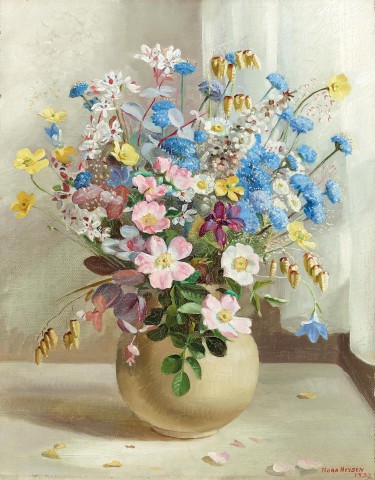FLORAL STILL LIFE, 1932
NORA HEYSEN
oil on canvas
51.0 x 41.0 cm
signed and dated lower right: NORA HEYSEN / 1932
Uppsala Auktionskammare, Sweden, 12 Dec 2019, lot 964
Private collection, Germany
Nora Heysen is an Australian artist of remarkable achievement. First, she had to make a name for herself independent of her famous father Hans Heysen (1877 – 1968). Secondly, she had to battle against times when women were not given recognition in the art world as they are today. Nora’s rise was spectacular. By the age of twenty she was already represented in three State Galleries – the Art Gallery of New South Wales, Art Gallery of South Australia and the Queensland Art Gallery. And her still-life paintings were to the fore. The Sydney gallery purchased Petunias, 1930 the same year it was painted. In 1931 the Queensland Art Gallery acquired A Mixed Bunch, also painted in 1930. In 1933, at the age of twenty-two, she held her first solo exhibition at the Royal South Australian Society of Arts Galleries, Adelaide, showing thirty still lifes, twelve portraits and a number of drawings. It was the year after Floral Still Life, 1932 was painted, the show’s outstanding success helping to finance her studies in London during the years to follow. That same year of 1933 the Royal South Australian Society of Arts awarded Heysen its Melrose Prize for Portraiture for Ruth. A success topped by its purchase the next year by the Art Gallery of South Australia.
In 1938 Heysen became the first woman to win the Archibald Prize with her portrait of Madame Elink Schuurman, significantly a female subject. Another first came in mid-1943 when she was appointed an Australian war artist, coming into conflict with officialdom over being restricted to painting ‘women of the services’. Later she was honoured with retrospective exhibitions at South Australia’s Old Clarendon Gallery, in 1984; the National Trust’s S. H. Ervin Gallery, Sydney in 1989; and the National Library of Australia, Canberra in 2000. More recently, Melbourne’s National Gallery of Victoria presented the major retrospective exhibition, Hans and Nora Heysen: Two Generations of Australian Art during 2019.
Paintings of the 1930s are especially significant among all of those above – portraits awarded prizes and the still-life paintings acquired by State Galleries – much admired for their outstanding qualities. Such recognition has continued over the years. In the twenties, Eggs, 1927 became part of the Howard Hinton Collection of the New England Regional Art Museum, Armidale, a gift of Howard Hinton in 1933. Of more recent times the Art Gallery of South Australia was enriched by three still-life paintings from the early 1930s – Fruit in a Yellow Bowl, 1930; Spring Flowers from the Bush, 1931; and Still Life – Cabbage, 1933, all through the Elizabeth and Tom Hunter Bequest in 2009.
Nora Heysen’s focus on still life flower pieces and portraits was a quite conscious choice, as Colin Thiele, Hans Heysen’s biographer points out, ‘to avoid working in the same field as her father’.1 Nevertheless, she acknowledged her father and that of the seventeenth-century Dutch master Jan Vermeer as her greatest influences in those years. This is quietly apparent in her handling of light, form and colour in Floral Still Life. Based on solid academic representation and delighting in the stillness of the moment, the blue cornflowers play a dominant role by numbers among the pink Rugosa roses, yellow Welsh poppies and white daisies, symbols of purity and innocence. The blue cornflowers should not be wondered at – as a national symbol of Germany they reflect the Heysen background. Australian eucalyptus is likewise present.
1. Thiele, C., Heysen of Hanhdorf, David Heysen Productions, revised edition, Adelaide, 2001, p. 245
DAVID THOMAS
